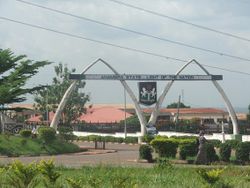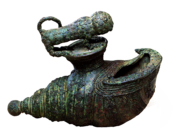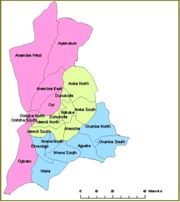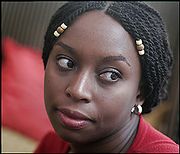Anambra State
| Anambra | |
|---|---|
| — State — | |
 |
|
| Nickname(s): Light of the Nation | |
 |
|
| Coordinates: | |
| Country | |
| Date created | 27 August 1991 |
| Capital | Awka |
| Government | |
| - Governor[1] | Peter Obi (APGA) |
| Area | |
| - Total | 4,844 km2 (1,870.3 sq mi) |
| Area rank | 35 of 36 |
| Population (2006 census)1 | |
| - Total | 4,055,048 |
| - Rank | 10 of 36 |
| - Density | 837.1/km2 (2,168.2/sq mi) |
| GDP (PPP) | |
| - Year | 2007 |
| - Total | $6.76 billion[2] |
| - Per capita | $1,585[2] |
| Time zone | WAT (UTC+01) |
| ISO 3166 code | NG-AN |
| Website | anambrastateng.org |
| ^1 Preliminary results | |
Anambra is a state in south-eastern Nigeria. Its name is an anglicized version of the original 'Oma Mbala', the name of the river now known as Anambra which the state is named after. The Capital and the Seat of Government is Awka. Onitsha and Nnewi are the biggest commercial and industrial cities, respectively. The state's theme is "Light Of The Nation". Boundaries are formed by Delta State to the west, Imo State and Rivers State to the south, Enugu State to the east and Kogi State to the north. The origin of the name is derived from the Anambra River (Omambala) which is a tributary of the famous River Niger.
The indigenous ethnic group in Anambra state are the Igbo (98% of population) and a small population of Igala (2% of the population) who live in the western part of the state.[3]
Anambra is the eight most populated states in the Federal Republic of Nigeria and the second most densely populated state in Nigeria after Lagos State. The stretch of more than 45 km between Oba and Amorka contains a cluster of numerous thickly populated villages and small towns giving the area an estimated density of 1,500–2,000 persons living within every square kilometer of the area.
Contents |
Resources
Anambra is rich in natural gas, crude oil, bauxite, ceramic and has an almost 100 percent arable soil. Most of its natural resources is largely untapped.
In the year 2006, foundation laying ceremony for the first Nigerian private refinery Orient Petroleum Refinery (OPR) was made at Nsugbe-Umuleri area [1]. The Orient Petroleum Resource Ltd, (OPRL) owners of OPR, was licensed in June 2002, by the Federal Government to construct a private refinery with a 55,000 b/d capacity.
Furthermore, Anambra state is a state that has many other resources in terms of agro-based activities like fishery and farming, as well as land cultivated for pasturing and animal husbandry.
History

Anambra possesses a history that stretches back to the 9th century AD, as revealed by archaeological excavations at Igbo-Ukwu and Ezira; Great works of art in iron, bronze, copper, and pottery works belonging to the ancient Kingdom of Nri, revealed a sophisticated divine Kingship administrative system which held sway in the area of Anambra from c. 948 AD to 1911.
During the Nigerian/Biafran war, a relief airstrip, was constructed by Biafran Engineers in the town of Uli/Amorka(code named "Annabelle"). Extremely dangerous relief flights took off from Sao Tome and other sites loaded with tons of food and medicine for the distressed Biafran population. Uli/Amorka airstrip was the site were brave American pilots like Alex Nicoll, and scores of others, made the supreme sacrifice in the service of humanity, delivering tons of relief supplies to the Biafran population.[4] Disgusted by the suffering and mounting death toll in Biafra from starvation as well as the continuous harassment of the relief planes by the Nigerian Airforce, Carl Gustaf von Rosen resigned as a Red Cross relief pilot and helped Biafra to form an Airforce of five Minicoin planes malmo MFI-9 stationed at the Uga airstrip.He named his tiny but effective airforce "Babies of Biafra" in honour of the babies who died via starvation inside Biafra.
Old Anambra State was created in 1976 from part of East Central State, and its capital was Enugu. A further re-organisation in 1991 divided Anambra into two states, Anambra and Enugu. The capital of Anambra is Awka.
Culture and Tourism
Agulu Crocodile Lake is located along Awka road in Agulu, Aniocha Local Government Area of the state. A potential tourist site, it is home to an estimated three hundred crocodiles and water turtles. Fishing is not allowed on the lake and the crocodiles, being sacred animals to the people, cannot be killed. Legend says that these crocodiles were instrumental in delivering the town from enemy soldiers during the Nigerian civil war. It is believed that these sacred crocodiles and turtles transformed themselves into beautiful ladies and lured the soldiers unawares into the lake where they disappeared without trace. At noon the crocodiles and the turtles appear at the banks of the lake to take in sunlight.
Ogbunike Caves, listed by UNESCO[2] as a world Heritage Site is one of the most visited tourist sites in Anambra State. It is classified as a Sandstone cave (Lateritic sandstones of Campanian-Miocene age)[3]. It has very scenic vegetation with attractive waterfall. It is situated in the Ogba hills Ogbunike, across the Ugwu-Aga Escarpment Umunya by the Enugu/Onitsha Expressway and lies in the coordinates of N06 11 11 and E06 54 21.
Igbo Ukwu Museum: lgbo Ukwu [4] is an ancient town known for astonishing metalcrafts and has remained an attraction to tourists because of its bronze artifacts. The bronzes which were first noticed in 1938 and later excavated by Thurstan Shaw (an English archaeologist) date back to about the 9th century, are of high value and historic relevance.
Uzu-Oka: Awka is historically known for the great metal foundary, Uzu Craftmanship. Imo-Awka is an annual festival celebrated by the natives.

Other Anambra tourism potentials and cultural festivals include:
- Ijele Masquerade listed in UNESCO Archives as Intangible cultural element [5] Ijele dance festival is home to the Olus of Omambala area: Aguleri, Umuleri, Awkuzu, Umunya, etc.
- Omaba Yearly New-Yam Festival.
- Umunya Apparition Site features monthly pilgrimage of devotees.
- Obu Gad at Enugwu Aguleri.
- Ini Iguedo (Iguedo Grave) at Nando.
- Odinani Museum at Nri.
- Ini Eri (Eri Grave) at Ivite, Aguleri
- The River Niger at Onitsha and Asaba with the famous Niger bridge is the eastern gateway linking the South East with Niger Delta and Western Nigeria.
- Umuoji Masquerade Promenade attracts thousands of visitors annually.
- Ofala (Ovala) Festival is the commemorative of Kingship celebrated by various towns. It was popularised by Onitsha town.
- Igu-Aro is the major kingship festival among the Nri.
- Nkpokiti Dance, Umunze is known for fantastic acrobatic performances.
- St Mary's Catholic Church, Nnokwa whose imposing dome dominates the skyline kilometers away.
- The Basilica of the Most Holy Trinity, Onitsha (also host the grave of the Blsd. Father Iwene Tansi)[6][7].
- Rogeny Tourist Village at Oba (a stadium that is equipped with recreational activities including a swimming pool, zoo, shrine, soccer stadium, etc.)
Education

Awka, the state capital, is also the center of Nigeria's metalwork and carving industries. Educationally, Anambra is a centre of excellence. There are the Nnamdi Azikiwe University (UNIZIK), Awka a federal university with College of Medicine situated at Nnewi. The UNIZIK Nnewi runs a modern Teaching Hospital with facilities also at Umunya and Ukpo.
The Anambra State University, formerly known as Anambra State University of Science and Technology (ASUTECH), with two campuses, one in Uli, and another at Igbariam; the Federal Polytechnic, Oko; Nwafor Orizu University of Education (formerly known as the Nwafor Orizu College of Education), Nsugbe. Private Universities include The Tansian University, Umunya and Madonna University, Okija. There is also the St Don Bosco Youth Training Centre at Ugwuagba (near Mgbuka Market), Obosi.
Literacy rate in the state is comparatively high. Some of the more notable secondary schools include St Charles' Special Science School (SCSSS), Onitsha; Christ the King college (C.K.C) Onitsha; Our Lady's High School, Onitsha; Comprehensive Secondary School Nawfia; Dennis Memorial Grammar School (D.M.G.S) Onitsha; Queen Of the Rosary College (Q.R.C.) Onitsha, St. Monica's College, Ogbunike, Nnamdi Azikiwe Secondary School, Abagana; St Mary's High School, Ifite-Dunu; Igwebuike Grammar School, Awka; Father Joseph Memorial High School, Aguleri; Girls High School, Umunya and Community Secondary School Igbariam. Primary and secondary school enrollment in the state is one of the highest in the country. Consequently, Anambra state has the highest number of JAMB candidates going after the limited number of spaces in Nigeria's tertiary colleges.
Politics

Anambra’s political history can be described as awesome, weird and unique depending on the aspect one turns to. It is a state with a long list of “firsts” in Nigeria history that dubbed the sobriquet “The Light of The Nation”. On May 29, 1999, Dr. Chinwoke Mbadinuju was sworn in as civilian governor of Anambra state, after many years of military rule. His administration was marred by heavy problems. The most notable is the teachers' salary which was withheld for a long time. This led to a ten-months strike in all the government secondary schools in the state. Also, before his rule, secondary education had been free of charge. But his administration prescribed a tuition fee of 3000 Naira per term for all secondary schools, which led to an unprecedented massive demonstration by the secondary school students from all over the state. Many people attribute Mbadinuju's failure to political godfathers a debacle that also trailed his predecessor. On May 26, 2003, Dr. Chris Ngige was sworn in as the new governor of the state, but he was removed in March 2006 when Mr. Peter Obi of APGA dragged him to court on charges of electoral malpractice. The Court of Appeal in Enugu asserted that his election victory in 2003 was fraudulent and ordered him to leave the seat.[5] Peter Obi was in turn ousted by a faction of the Anambra State House of Assembly on November 2, 2006 and replaced by Virginia Etiaba, his deputy.[6] On February 9, 2007 Mrs. Etiaba handed power back to Obi after the Court of Appeal had nullified Obi's removal.[7]
On April 14, 2007, Mr. Andy Uba of PDP was "elected" the new governor of the state and, on May 29, was sworn in as the new governor. The election was reported to be massively rigged and was disapproved all over the country. On June 14, 2007 the Supreme Court of Nigeria removed Mr. Andy Uba from office and replaced him with his predecessor Peter Obi, on the ground that Peter Obi's tenure had not ended, therefore there was no vacancy in the governorship. [8] On Saturday, 6 February 2010, Peter Obi was re-elected governor for a second term of four years, after a hot contest with Dr. Chris Ngige, a former governor of the state; Prof. Charles Soludo, a former governor of the Central Bank of Nigeria and Mr. Andy Uba who was a strong voice in the state's politics. Other contenders included Mrs Uche Ekwunife, Prince Nicholas Ukachukwu and many others. Altogether, there were twenty-five contestants for the office. Mr. Peter Obi was named the winner of the election, with more than 30% votes above the immediate runner-up.
Cities and administrative divisions

With an annual population growth rate of 2.21 percent per annum, Anambra State has over 60% of its people living in urban areas making it one of the most urbanized places in Nigeria.
The major urban centres of Anambra state are Onitsha including Okpoko, Nnewi, and Awka. Awka and Onitsha developed as pre-colonial urban centres with Awka as the craft industrial centre of the Nri hegemony; and Onitsha the city state on the Niger and a river port and commercial centre.
Onitsha is a fast-growing commercial city, and has developed to become a huge conurbation extending to Idemili, Oyi and Anambra East LGAs with one of the largest markets in West Africa. Nnewi (the Taiwan of Nigeria) is a rapidly developing industrial and commercial centre; and Awka, by becoming the state capital is, as it were, regaining its precolonial administrative eminence.
Other main towns of Anambra state are: Igbariam, Nkwelle-Ezunaka, Abatete, Awka-Etiti, Achina, Agulu, Amorka, Aguluezechukwu, Ogidi, Obosi, Ihiala, Amichi, Uga, Uli,Ubuluisiuzor, Abagana, Alor, Nsugbe, Atani, Nkpor, Eziowelle, Oba, Omor, Ichi, Ojoto, Oraifite, Ozubulu, Umuawulu, Umuoji, Umunachi, Umudioka, Unubi, Umunya, Umuleri, Utuh, Ogbunike, Aguleri, Ekwulobia, Igbo-ukwu, Ichida, Ora-Eri, Ihembosi, Akwaukwu, Uke, Ukpo, Ifite - Dunu, Okija, Oko, Oraukwu, Osumenyi, Otu-ocha, Nnobi, Nnokwa, Ideani, Adazi-Nnukwu, Adazi-Enu, Umuanaga, Adazi Ani, Nanka, Nimo, Nneni, Nmiata-Anam, Awkuzu, Ebenebe, Enugwu-Ukwu, Enugwu-Agidi, Umueze-Anam, Nawfia, Amawbia, Agukwu, Nando, Nanka, Nnokwa, Amansea, Amanuke, Achalla, Mgbakwu, Ugbenu, Ugbenne, Umuchu, Umuomaku, Isuaniocha, Azia, Utuh, Akwaeze, Omogho, Amesi, Ebenator, Nibo, Mbaukwu, Nise, Achala, Ukpor.

There are 21 local government areas in the state:
- Aguata
- Awka North
- Awka South
- Anambra East
- Anambra West
- Anaocha
- Ayamelum
- Dunukofia
- Ekwusigo
- Idemili North
- Idemili South
- Ihiala
- Njikoka
- Nnewi North
- Nnewi South
- Ogbaru
- Onitsha North
- Onitsha South
- Orumba North
- Orumba South
- Oyi
Urbanization and Structural Planning
Over the last two decades the rural/urban exodus has caused a shift making Anambra a highly urbanized state with 62% of its population living in urban areas.
Faced with decades of neglect and bad governance, the shift in human migration has posed problems to available infrastructural provision, environmental sanitation, erosion control and other social services. As a result, major cities have become characterized by inadequate and deteriorated road networks, walkways, unregulated building patterns, sanitation, uncontrolled street uncontrolled street trading, mountains of garbage, and chaotic transport systems, creating congestion, noise pollution and overcrowding.
To address this situation, the government of Peter Obi with the assistance of the UN-HABITAT produced 20-year structural plans (2009–2028) for three major cities in the State, Onitsha, Nnewi and Awka Capital Territory to restore urban planning and guide their growth into the future.
The plans contain policies and proposals for land use, city beautification, road infrastructure, industrial development, housing, waste disposal, water supply and health and educational facilities to turn the cities into Anambra into successful urban areas to generate employment, wealth and provide high living standards for its residents.[8]
Anambra became the first state in Nigeria to adopt Structural Plans for its cities and with effective implementation should systematically grow as a major economic center in Nigeria and West Africa.
Famous people

Despite its relatively small landmass, Anambra has produced a fair number of outstanding individuals and a number of firsts in Nigeria. Anambra boasts:
- Professor Chinua Achebe - a native of Ogidi and best known for the classic, Things Fall Apart was the first African writer whose books are standard curricula in schools and universities across the world.
- Emeka Anyaoku - the first black Secretary-General of the Commonwealth;
- Nnamdi Azikiwe Owelle of Onitsha - the first President of the Federal Republic of Nigeria and historically, the only man whose name appeared in the Constitution of his country (Nigeria's Republican Constitution of 1963).
- Nwafor Orizu - the first Senate President of the Federal Republic of Nigeria.
- Professor Kenneth Dike - a pre-eminent scholar of African History and native of Awka, was the first indigenous Vice-Chancellor of the University of Ibadan and founder of the National Archives.
- Professor Ben Enwonwu - a native of Onitsha was the first Nigerian sculptor of international repute with artwork gracing the United Nations headquarters.[9]
- Igwe (Prof) J.C. Menakaya [9], a native of Umunya and the first Igbo Education Officer was a pioneer of Teacher policy formulation, the best in Africa south of the Sahara.
- Pius Okigbo, CON[10] - a world renowned economist, was the first economic advisor to the Federal government of Nigeria (1960–1962), first Nigerian Ambassador to the European Community and renowned for bringing to light over $12 billion missing in oil windfall receipts from the Central Bank of Nigeria during the first Gulf War.
- Professor Samuel Okoye - was black Africa's first PhD in Radio Astronomy who along with Anthony Hewish of the University of Cambridge discovered the radio source of Crab Nebula neutron star.
- Chief Jerome Udoji - from Ozubulu [11], a social reformer was the first African to be made a 'D.O' (District Officer) by the Colonial Administration.

Others include:
- Chimamanda Adichie - an up-and-coming writer who won the Orange Prize for Fiction (2007) and a MacArthur Foundation Fellowship (2008);
- Dora Akunyili - ex-head of NAFDAC and current Minister of Information won international awards for cleansing Nigeria of the scourge of fake drugs;
- Cardinal Francis Arinze - once considered a potential Pope;
- Pete Edochie - MON famous Nollywood actor,
- Cyprian Ekwensi - MFR, a writer of international repute
- Philip Emeagwali - winner of the 1989 Gordon Bell Prize for Supercomputing;
- Augustine Ilodibe - transport owner of the famous Ekene Dili Chukwu Bus Company;
- Ernest Ndukwe - [10] who as Executive Vice Chairman of the Nigerian Communication Commission was responsible for creating innovative policies that helped usher in a mobile telecommunications revolution in Nigeria that has taken the country from less than 400,000 lines in 2001 to over 65 million lines in 2010.
- Prof Ben Nwabueze - the first Nigerian academic SAN and leader of Ohaneze Ndigbo [12];
- Prof Chike Obi - a Mathematician famous for his work on non-differential equations won the 1985 ICTP Price [13] and developed a special solution for Fermat's Last Theorem [14];
- Louis Odumegwu Ojukwu - a native of Nnewi who was the first Nigerian millionaire and first president of the Nigerian Stock Exchange;
- Dim Emeka Ojukwu - the leader of the secessionist Biafra Republic;
- Mike Okpala (Power Mike)[15] - a World Heavyweight Wrestling Champion;
- Osita Osadebe - a popular Nigerian Highlife musician who also holds the Nigerian record for the highest selling album
- Professor Charles Chukwuma Soludo - a famous economist who spearheaded Nigerian economic reform from 1999–2008 and was ex-head of the Central Bank of Nigeria;
- Austin Arinze Obiefuna - winner of the UNION Karel Styblo Prize 2008 for exceptional work in the fight against tuberculosis;
- Mikel John Obi - Super Eagles Footballer
- Cyprian Emeka Uzoh - is an IBM Corporate Fellow and holds 150 patents in semiconductor technology.[11]
In 1977, Christ the King College (CKC) Onitsha students became the first Nigerian school side to win the World Schools Soccer Competition hosted in Dublin, Ireland [16].
References
- ↑ See List of Governors of Anambra State for a list of prior governors
- ↑ 2.0 2.1 "C-GIDD (Canback Global Income Distribution Database)". Canback Dangel. http://www.cgidd.com. Retrieved 2008-08-20.
- ↑ http://www.igbofocus.co.uk/html/anambra_state.html
- ↑ http://ajcarchives.net/AJC_DATA/Files/661.PDF
- ↑ "Ngige out, Obi in as Anambra gov". http://www.guardiannewsngr.com. The Guardian (Lagos), Thursday, March 16, 2006. http://odili.net/news/source/2006/mar/16/18.html. Retrieved 2007-02-10.
- ↑ "Anambra: How Etiaba Became Governor". http://www.thisdayonline.com. This Day (Lagos), Saturday, November 4, 2006. http://www.thisdayonline.com/nview.php?id=62287. Retrieved 2007-02-10.
- ↑ "Obi Floors Lawmakers - Take Over From Etiaba". http://www.tribune.com.ng. Nigerian Tribune (Lagos), Saturday, February 10, 2007. http://www.tribune.com.ng/10022007/news/news2.html. Retrieved 2007-02-10.
- ↑ http://www.unhabitat.org/content.asp?cid=7109&catid=223&typeid=13&subMenuId=0
- ↑ http://secint50.un.org/av/photo/detail/0126482.html?browse=all.html
- ↑ http://www.itu.int/osg/csd/wtpf/wtpf2009/bios/Ndukwe.html
- ↑ http://www.panapress.com/freenews.asp?code=eng005408&dte=12/10/2006
Sources
- http://www.theunion.org/fr/Page-10.html
- http://www.finddiagnostics.org/media/conference-reports/lung_health_conf2008/index.html
- http://www.theunion.org/newsletter/newsletter-october.html
- Igboegbunam, Okechukwu Lawrence: Sustainable Tourism Development For Anambra State Nigeria (Application of Leadership Concept in setting up an Eco-tourism Potential, "Plateau Rivulet Trail"), Institute Optopreneur, Malaysia. 2009
- http://www.sunnewsonline.com/webpages/features/arts/2008/aug/26/arts-26-08-2008-002.htm
- http://jcmedufoundation.org/Lecture1.html
- http://books.google.com/books?id=ZTNOEimkkEcC&pg=PA30&lpg=PA30&dq=J.C.+Menakaya&source=bl&ots=HculEsAIBo&sig=LDszJ1taIH1_GRPJpApABnr-3bo&hl=en&ei=g8lqS7H0FYH-sQP2mMGYAw&sa=X&oi=book_result&ct=result&resnum=1&ved=0CAcQ6AEwADgK#v=onepage&q=J.C.%20Menakaya&f=false
External links
- Government of Anambra
- Satellite Map of Anambra State on Google Maps World Gazetteer
|
|||||||||||
|
||||||||||||||||||||
|
|||||